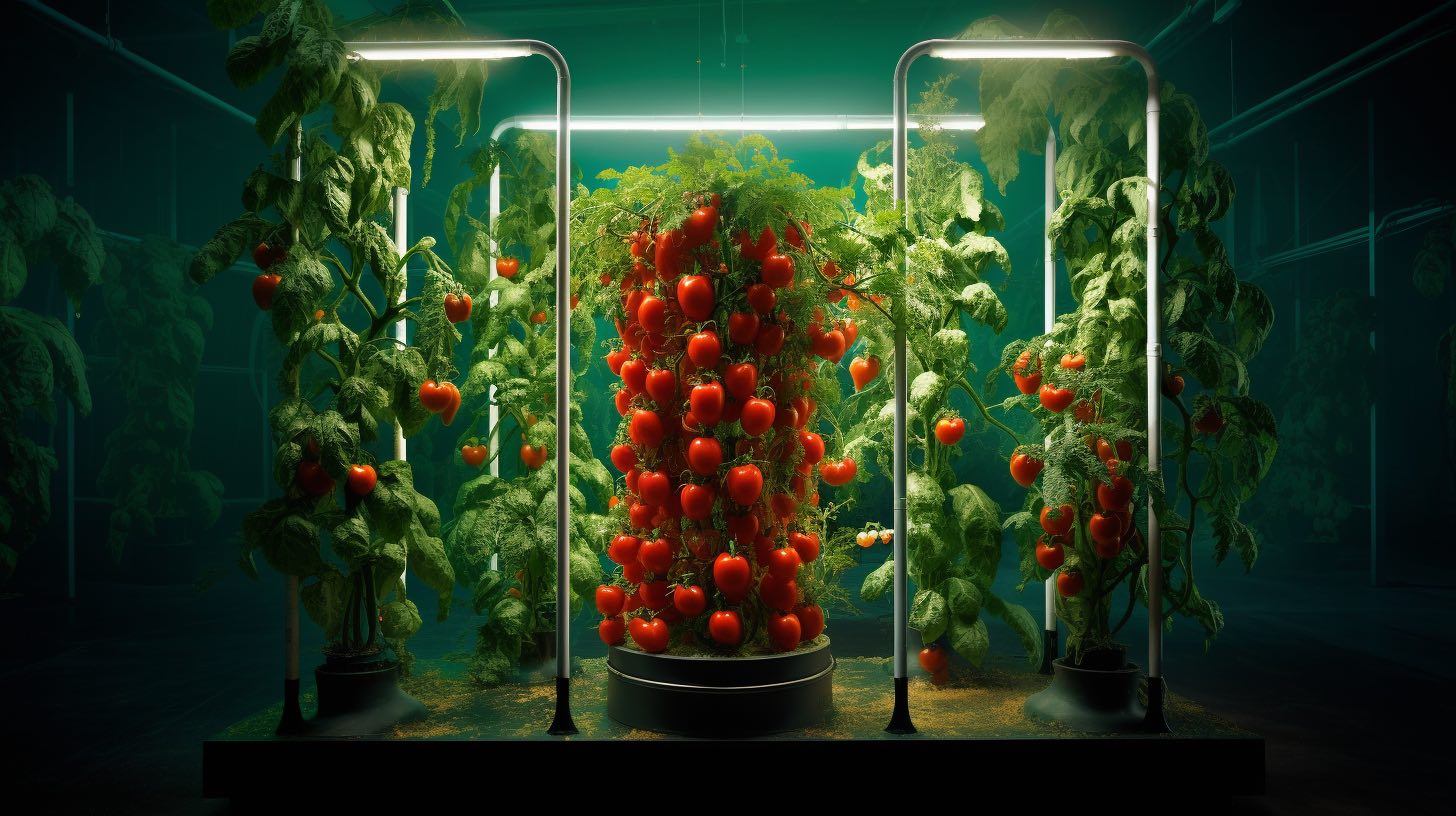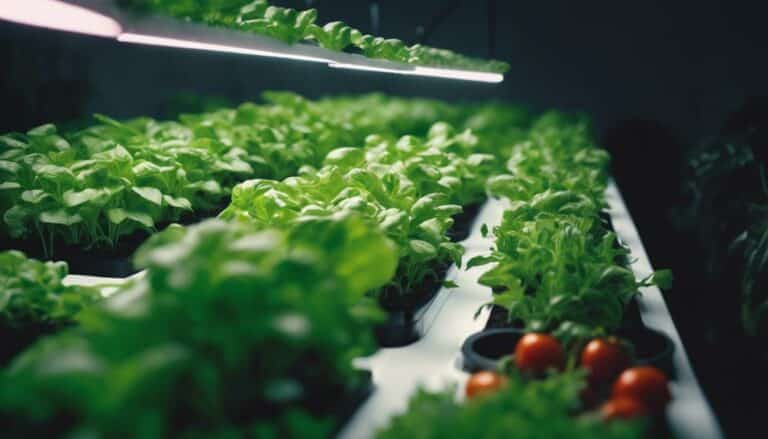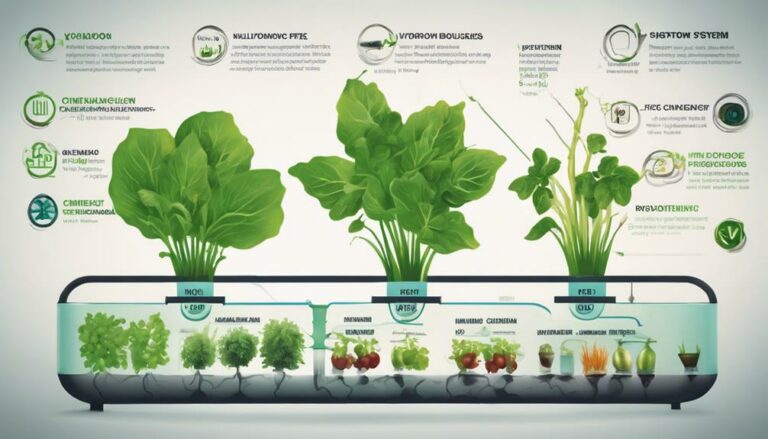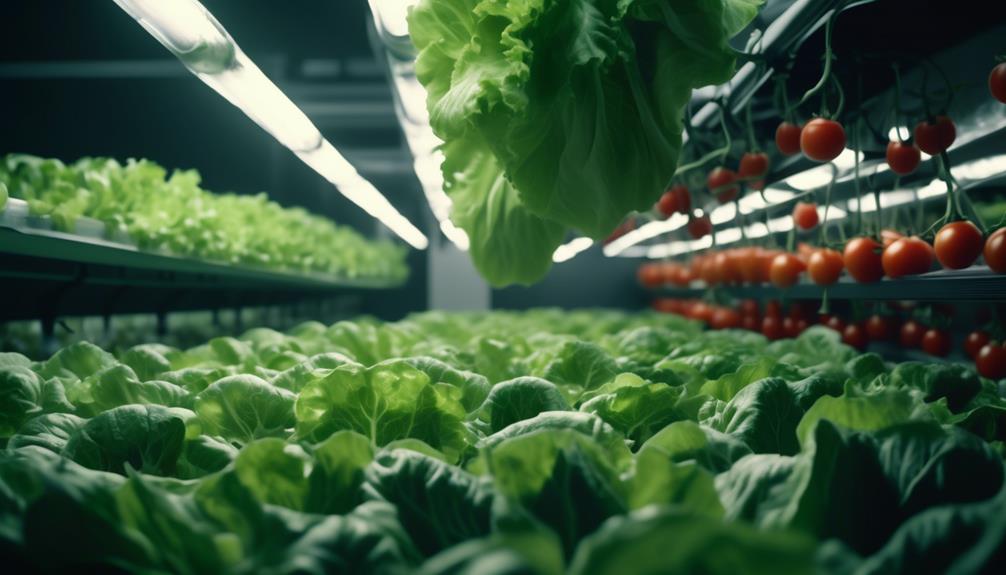I’ve discovered an exciting way to cultivate tomatoes and peppers – hydroponic systems. These innovative setups allow for precise control over nutrient levels, pH, and temperature, resulting in healthier plants and higher yields.
In this article, I’ll guide you through the basics of hydroponics and the various types of systems available. I’ll also provide tips on choosing the right nutrient solutions, essential equipment, and techniques for maintaining optimal conditions.
Table of Contents
Get ready to revolutionize your tomato and pepper growing with hydroponics.
Key Takeaways
- Hydroponic systems for tomato and pepper cultivation involve growing plants without soil using a nutrient-rich water solution.
- Nutrient Film Technique (NFT) and Deep Water Culture (DWC) are two commonly used hydroponic systems for tomatoes and peppers.
- Hydroponics offers benefits such as water and resource conservation, minimized pesticide usage, and the ability to cultivate in non-arable areas.
- Choosing the right hydroponic nutrient solutions is crucial, as tomatoes and peppers have specific nutritional needs that should be met for optimal growth and yield.
The Basics of Hydroponics for Tomato and Pepper Cultivation
I find the basics of hydroponics for tomato and pepper cultivation fascinating. With hydroponics, plants are grown without soil, using a nutrient-rich water solution instead. Understanding the hydroponic nutrient requirements is essential for successful cultivation.
Plants require a balanced mix of macronutrients such as nitrogen, phosphorus, and potassium, as well as micronutrients like iron, zinc, and copper. These nutrients are dissolved in the water solution and delivered directly to the roots, promoting optimal growth and development.
Additionally, the choice of hydroponic growing medium plays a crucial role in supporting the plants. Commonly used mediums include perlite, coco coir, and rockwool, which provide stability, aeration, and moisture retention.
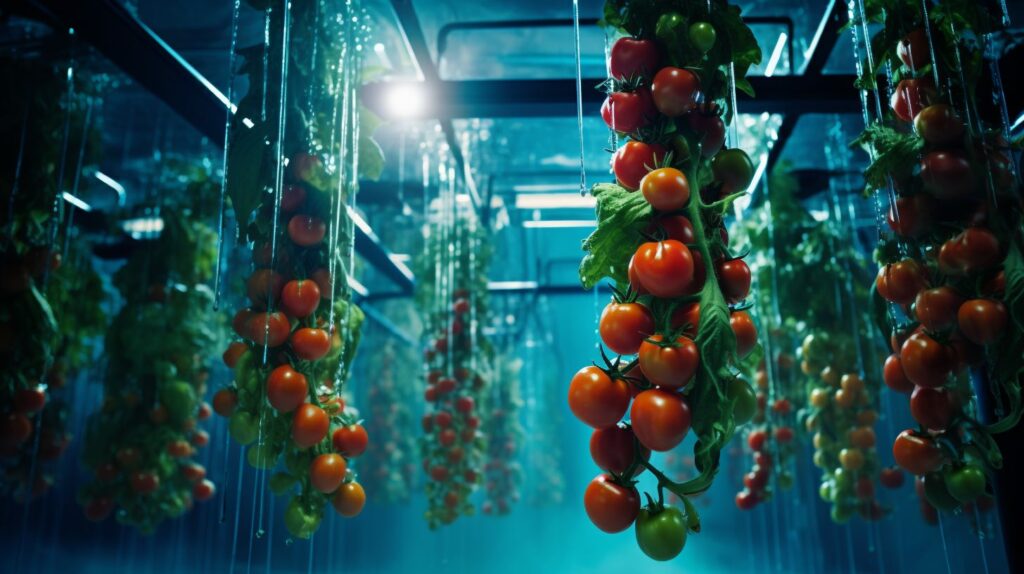
Types of Hydroponic Systems for Tomato and Pepper Plants
For growing tomatoes and peppers, I prefer using the nutrient film technique (NFT) and deep water culture (DWC) systems. These hydroponic systems offer several benefits for cultivating these crops.
- NFT system:
- Constant flow of nutrient-rich solution promotes optimal growth and development.
- Reduced water usage compared to traditional soil-based methods.
- Easy monitoring and adjustment of nutrient levels for precise control.
- DWC system:
- Deep water reservoir provides constant access to water and nutrients.
- Enhanced nutrient uptake leads to faster growth and higher yields.
- Eliminates the need for soil, reducing the risk of soil-borne diseases.
To maintain these hydroponic systems effectively, regular maintenance is crucial. This includes monitoring pH and nutrient levels, ensuring proper water circulation, and preventing algae and pest infestations.
The benefits of hydroponic cultivation extend beyond increased yields and faster growth. They include water and resource conservation, minimized pesticide usage, and the ability to grow crops in non-arable areas. Embracing hydroponic systems not only offers innovation but also contributes to sustainable and efficient agriculture.
Choosing the Right Hydroponic Nutrient Solutions for Tomatoes and Peppers
When selecting the nutrient solutions for my hydroponic setup, I prioritize a balanced blend that meets the specific nutritional needs of my crops.
Hydroponic nutrient requirements for tomatoes and peppers are unique, as these crops have higher demands for certain nutrients such as nitrogen, phosphorus, potassium, calcium, and magnesium.
To ensure optimal growth and productivity, I carefully formulate nutrient solutions that contain these essential elements in the right proportions. This requires precise measurement and calculation, taking into account factors like plant stage, growth rate, and environmental conditions.
I also incorporate innovative techniques like foliar feeding and fertigation to enhance nutrient uptake and utilization.
Essential Equipment for Hydroponic Tomato and Pepper Growing
To successfully grow tomatoes and peppers hydroponically, I rely on essential equipment such as grow lights, reservoirs, and nutrient pumps. These hydroponic tools are crucial for providing the optimal growing conditions and ensuring the plants receive the necessary nutrients.
Grow Lights:
- LED lights: These energy-efficient lights mimic natural sunlight and provide the ideal spectrum for plant growth.
- High-pressure sodium (HPS) lights: These lights emit a warm, orange light that promotes flowering and fruit production.
- Metal halide (MH) lights: These lights emit a cool, blue light that stimulates vegetative growth.
Reservoirs:
- Water tanks: These containers store the nutrient solution and provide a stable water source for the plants.
- pH and EC meters: These devices measure the acidity and nutrient concentration of the solution, ensuring optimal conditions.
Nutrient Pumps:
- Submersible pumps: These pumps circulate the nutrient solution, delivering it to the roots and providing oxygenation.
Tips for Maintaining Optimal Ph Levels in Hydroponic Systems
Maintaining optimal pH levels in hydroponic systems is crucial for the health and productivity of plants. To achieve this, regular monitoring and adjustment of pH levels is necessary.
Ph Level Importance
I’ve learned that maintaining the proper pH level is crucial for the successful growth of tomatoes and peppers in hydroponic systems. The importance of nutrient balance and pH level monitoring can’t be overstated.
Here are some key points to consider:
- Nutrient Balance:
- Ensuring the right balance of essential nutrients is vital for healthy plant growth.
- Imbalances can lead to nutrient deficiencies or toxicities, hindering plant development.
- Regular monitoring and adjustment of nutrient levels is necessary to maintain optimal plant health.
- pH Level Monitoring:
- pH affects nutrient availability in the root zone.
- Tomatoes and peppers thrive in a slightly acidic environment, with a pH range of 5.5 to 6.5.
- Monitoring pH levels using a reliable testing method allows for timely adjustments to ensure optimal conditions for plant growth.
Adjusting Ph Levels
Now that we understand the importance of maintaining the correct pH levels in our hydroponic systems, let’s delve into the process of adjusting these levels.
Achieving the optimal pH range is crucial for the successful cultivation of tomatoes and peppers. To begin, regular pH level testing is essential to monitor any fluctuations in the nutrient solution. By using a reliable pH meter or test kit, we can accurately measure the acidity or alkalinity of our solution.
Once we identify any deviations from the desired range, adjustments can be made by adding either pH up or pH down solutions. pH up is used to raise the pH level, while pH down is employed to lower it.
It’s crucial to make gradual adjustments, allowing the nutrient solution to stabilize before retesting. This meticulous approach ensures that our plants receive the proper pH balance for optimal growth and productivity.
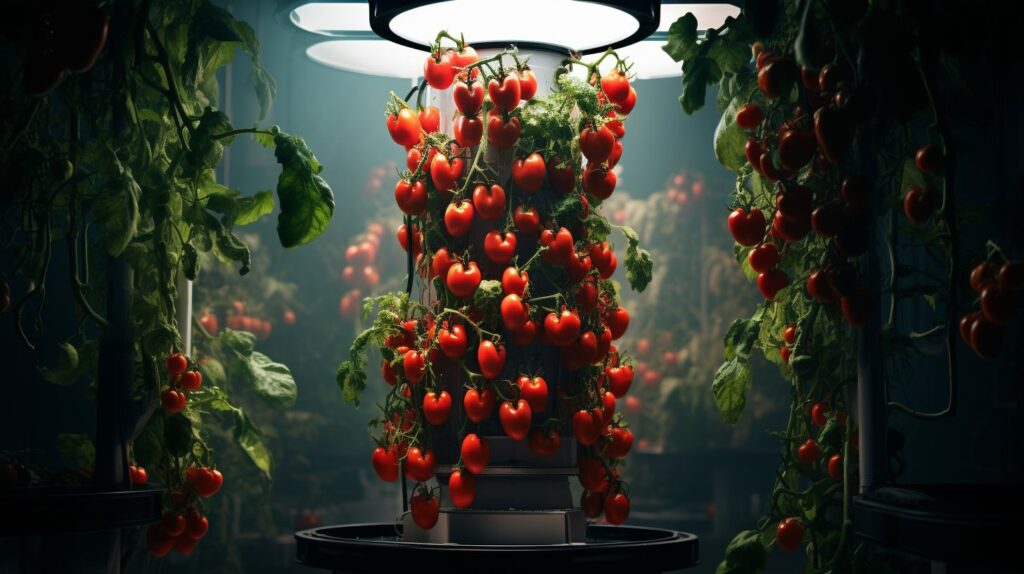
Managing Light and Temperature in Hydroponic Tomato and Pepper Cultivation
As a hydroponic farmer, I find it crucial to monitor and adjust the light and temperature levels in my tomato and pepper cultivation. These factors play a significant role in the growth and development of the plants, ultimately determining the quality and yield of the crops.
To manage light and temperature effectively, I employ the following strategies:
- Adjusting light intensity and duration:
- Utilizing LED grow lights to provide specific wavelengths of light tailored to the needs of the plants.
- Implementing light timers to ensure consistent and appropriate light exposure.
- Monitoring and adjusting light levels based on the growth stage of the plants.
Controlling temperature:
- Installing ventilation systems to regulate temperature and humidity levels.
- Implementing temperature sensors to monitor and maintain optimal growing conditions.
- Using cooling systems, such as fans or evaporative coolers, to prevent heat stress.
Pruning and Training Techniques for Hydroponic Tomatoes and Peppers
To optimize the growth and productivity of my crops, I implement pruning and training techniques in my indoor farming practices. These techniques are essential in vertical farming, where space is limited and plants need to be trained to grow in a controlled and efficient manner.
Pruning involves removing unwanted shoots and leaves, allowing the plant to focus its energy on fruit production. Training, on the other hand, involves guiding the plant’s growth along a trellis or support system, ensuring proper airflow and light penetration. Both techniques are crucial in maintaining the health and vigor of my hydroponic tomatoes and peppers.
Additionally, I pay close attention to hydroponic nutrient ratios, carefully balancing the various essential nutrients required for optimal growth. This scientific approach ensures that my crops receive the precise nutrients they need for maximum yield and quality.
Pest and Disease Control in Hydroponic Tomato and Pepper Gardens
I regularly monitor my indoor gardens for pests and diseases, implementing effective control measures to ensure the health and productivity of my crops. In order to maintain the organic nature of my hydroponic system, I rely on the use of beneficial insects and other organic pest control methods.
Here are three sub-lists that illustrate my approach:
- Beneficial Insects:
- Ladybugs: These voracious predators feed on aphids and other soft-bodied insects, providing natural pest control.
- Lacewings: Their larvae consume aphids, mites, and other harmful pests, preventing infestations.
- Predatory Mites: These tiny insects prey on spider mites, thrips, and other plant-damaging pests.
- Organic Pest Control Methods:
- Neem Oil: Derived from the neem tree, this natural pesticide disrupts the life cycle of insects and reduces their feeding ability.
- Diatomaceous Earth: Made from fossilized algae, it acts as a physical barrier to pests, causing them to dehydrate and die.
- Insecticidal Soaps: These potassium salt-based soaps suffocate pests by disrupting their cell membranes.
- Integrated Pest Management (IPM):
- Regular monitoring: By inspecting plants regularly, I can detect early signs of pests or diseases and take immediate action.
- Cultural Control Practices: Maintaining proper hygiene, such as removing dead plant material and providing sufficient air circulation, helps prevent pest and disease outbreaks.
- Crop Rotation: Rotating crops helps break pest life cycles and reduces the risk of recurring infestations.
Harvesting and Storing Hydroponically Grown Tomatoes and Peppers
When it comes to harvesting and storing hydroponically grown tomatoes and peppers, it’s crucial to follow precise procedures to maintain their quality and shelf life.
After carefully monitoring the plants for optimal ripeness, I employ proper harvesting techniques to ensure minimal damage.
Once harvested, I immediately transfer the produce to a controlled environment with specific temperature and humidity conditions to extend their shelf life.
Optimal Storage Conditions
As a researcher in the field of hydroponics, I’ve found that maintaining proper temperature and humidity levels is crucial for storing tomatoes and peppers. In order to ensure optimal storage conditions, it’s important to control the temperature and humidity levels within the storage facility. Here are three key factors to consider:
- Temperature control: Keeping the storage area at a temperature range of 55-60°F (13-16°C) helps to slow down the ripening process and extend the shelf life of tomatoes and peppers. Extreme temperatures can lead to spoilage and reduced quality.
- Humidity levels: Maintaining a humidity level of around 85-90% is ideal for storing tomatoes and peppers. This helps to prevent dehydration and maintain the overall freshness of the produce. High humidity levels can also reduce the risk of mold and bacterial growth.
- Ventilation: Proper air circulation is essential to prevent the buildup of ethylene gas, which can accelerate ripening and spoilage. Installing fans or ventilation systems can help to maintain a consistent airflow within the storage area.
Shelf Life Extension Strategies
Maintaining proper storage conditions is vital to extending the shelf life of tomatoes and peppers, ensuring their freshness and quality for a longer period. To achieve shelf life preservation, innovative post-harvest techniques can be employed.
One such technique is the use of modified atmosphere packaging (MAP). This involves controlling the atmosphere surrounding the produce by adjusting oxygen and carbon dioxide levels. By reducing oxygen and increasing carbon dioxide, the respiration rate of the tomatoes and peppers can be slowed down, thus delaying the ripening process and prolonging their shelf life.
Another technique is cold storage, where the produce is stored at low temperatures to inhibit microbial growth and enzymatic activity. Additionally, treatments such as ethylene inhibitors and antioxidants can be used to further enhance the shelf life of tomatoes and peppers.
These innovative strategies contribute to the preservation of freshness and quality, allowing for longer storage and transport times.
Frequently Asked Questions
How Often Should I Water My Hydroponic Tomato and Pepper Plants?
I water my hydroponic tomato and pepper plants based on their nutrient requirements and the recommended watering frequency. It ensures they receive the necessary hydration and nutrients for optimal growth and yield.
What Are Some Common Pests and Diseases That Affect Hydroponic Tomato and Pepper Plants?
Common hydroponic pests and hydroponic plant diseases can have a significant impact on tomato and pepper cultivation. Identifying and addressing these issues is crucial for successful hydroponic farming.
Can I Use the Same Hydroponic Nutrient Solution for Both Tomatoes and Peppers?
Yes, you can use the same hydroponic nutrient solution for both tomatoes and peppers. However, there are pros and cons to consider. It is important to choose the best hydroponic nutrient solutions for optimal tomato and pepper cultivation.
Do I Need Special Lighting Equipment for Growing Hydroponic Tomatoes and Peppers?
I need special lighting equipment for growing hydroponic tomatoes and peppers. It is crucial to provide the right spectrum and intensity of light to maximize growth and yield. This ensures the benefits of hydroponic cultivation are fully realized.
How Long Does It Take for Hydroponically Grown Tomatoes and Peppers to Reach Maturity?
It typically takes hydroponically grown tomatoes and peppers about 60-90 days to reach maturity. By providing the right hydroponic nutrients and using proper pruning techniques, we can optimize growth and achieve quicker results.
Conclusion
In conclusion, hydroponic systems offer a precise and efficient method for cultivating tomatoes and peppers. By carefully selecting the right hydroponic system, nutrient solutions, and equipment, growers can create optimal growing conditions and achieve bountiful harvests.
Maintaining proper pH levels, managing light and temperature, and implementing pruning and training techniques are crucial for successful cultivation. Additionally, effective pest and disease control measures ensure healthy plants.
With proper care and attention, hydroponically grown tomatoes and peppers can be harvested and stored for long-lasting enjoyment.

